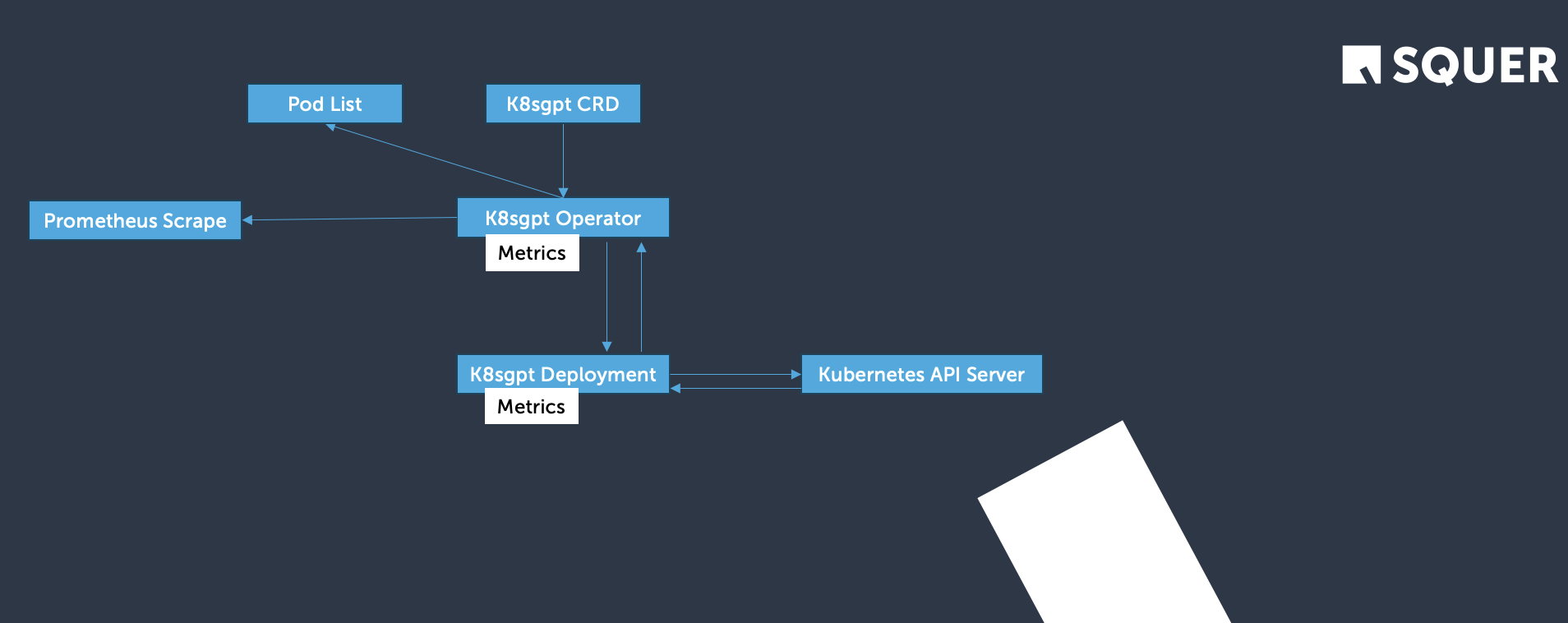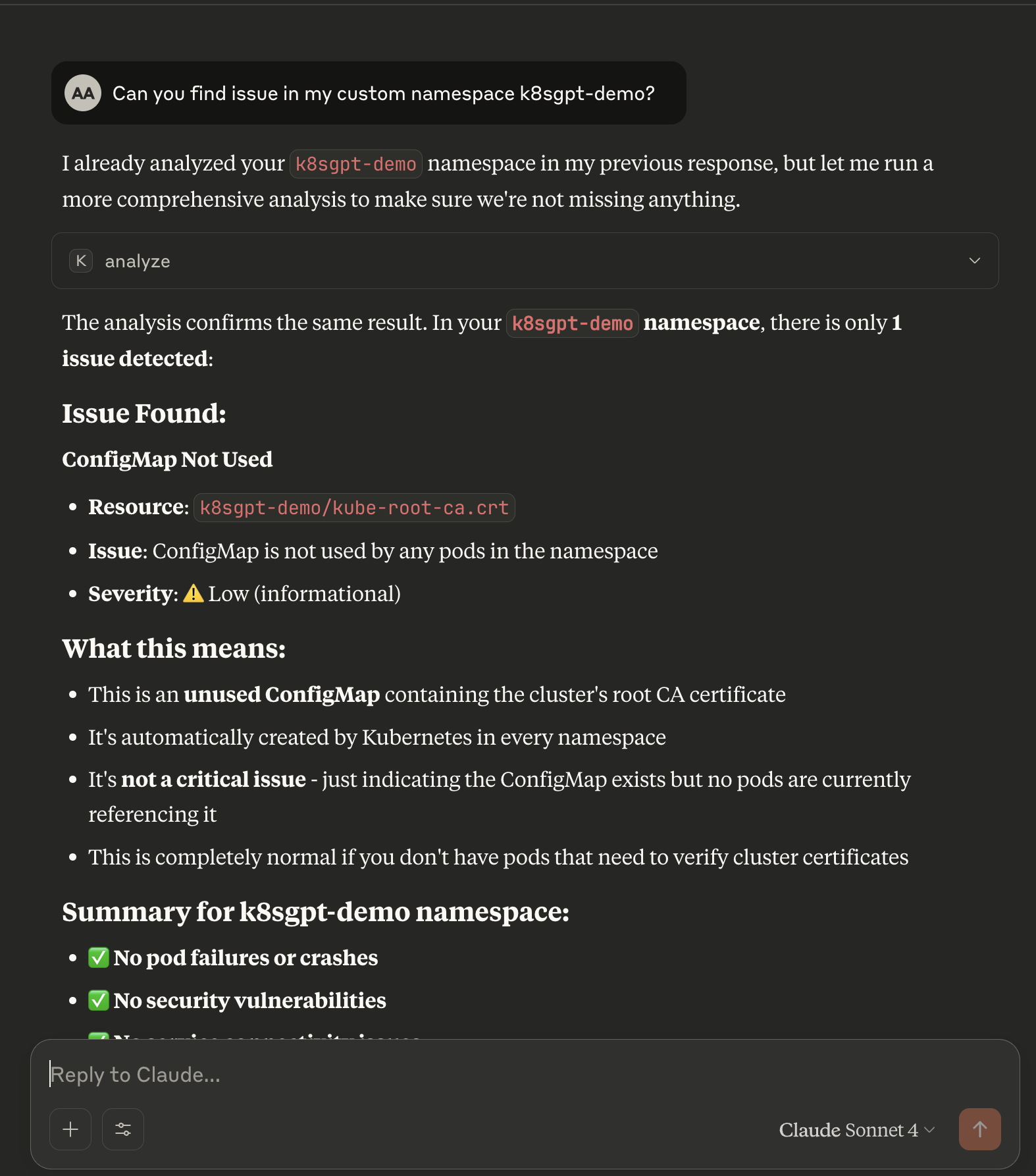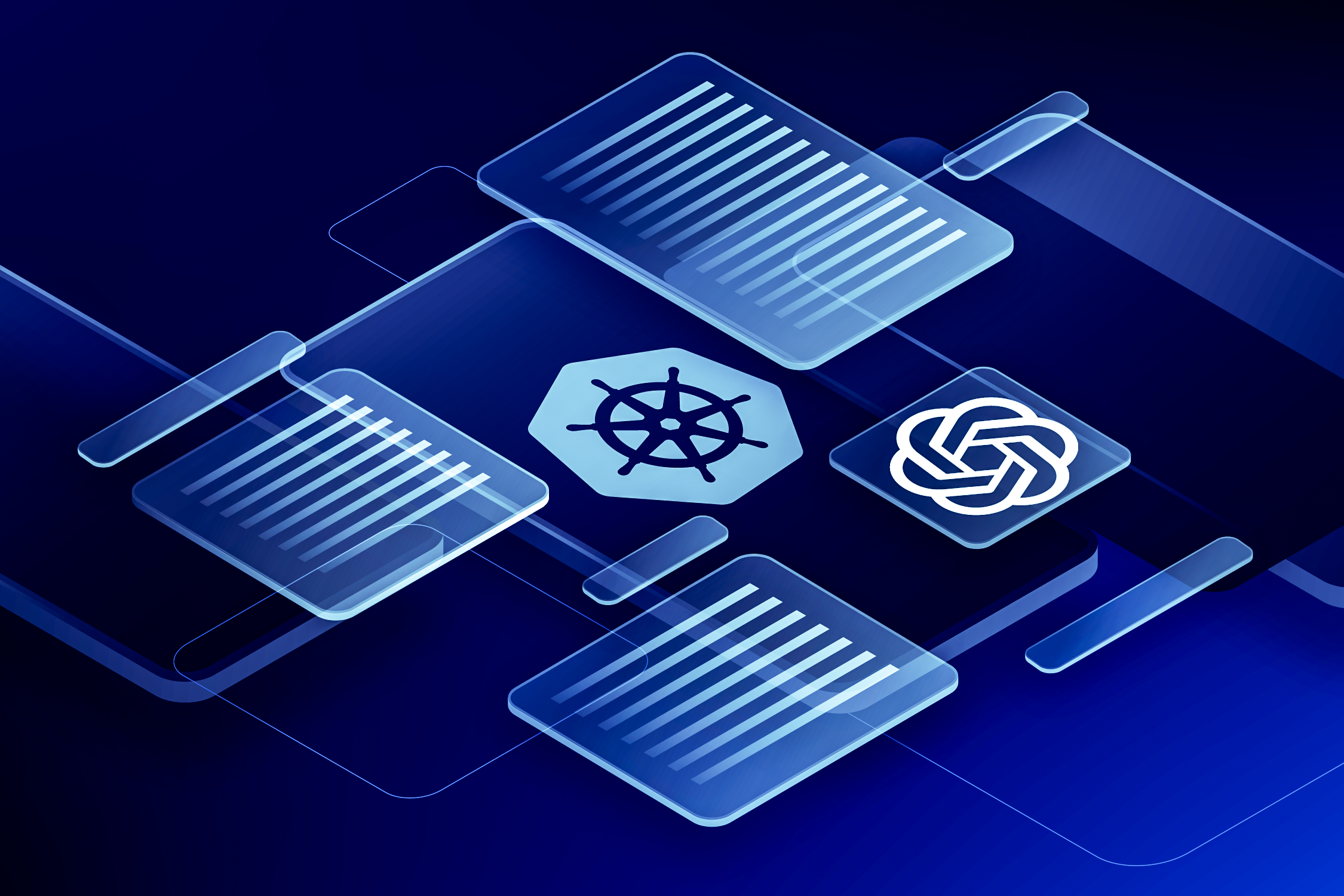Kubernetes is powerful—but debugging it can feel like a dark art. Even for seasoned DevOps engineers, diagnosing issues across Pods, Services, and YAML configurations often involves tedious log scraping, manual correlation, and hours of frustration. Monitoring tools flood your dashboards with metrics but rarely explain what went wrong or how to fix it. That’s where K8sGPT comes in. This CNCF Sandbox project pairs rule-based scanning with Generative AI to turn low-level Kubernetes errors into human-readable insights. From root cause analysis to policy compliance and developer onboarding, K8sGPT empowers teams to move faster, resolve incidents more confidently, and reduce cognitive overhead. In this article, you’ll learn how to run K8sGPT in your environment, use it with or without AI backends, and embed it into real-world SRE workflows to elevate your observability game.
🧠 Introduction: Why Kubernetes Needs AI Today
Kubernetes is powerful—but troubleshooting it is notoriously painful. Even seasoned DevOps engineers and SREs often find themselves sifting through cryptic logs, misconfigured YAMLs, and endless dashboards. Despite excellent monitoring tools, root cause analysis remains slow and manual.
Meet K8sGPT: An open-source diagnostic powerhouse that pairs rule-based analysis with Generative AI to explain Kubernetes issues in plain English—fast, smart, and developer-friendly.
In this blog, you'll learn:
✅ What K8sGPT is and how it works
✅ How to run it locally using Minikube
✅ Benefits of the K8sGPT Operator for real-time insights
✅ Key integrations and privacy features
✅ Why it's becoming essential in modern SRE workflows
Let's explore how K8sGPT transforms your Kubernetes observability game.
🔍 What Is K8sGPT? A Quick Overview
K8sGPT is a Kubernetes diagnostic tool that scans your cluster, detects issues, and translates technical failures into human-readable explanations using AI.
📢 Highlights
- 🌐 Launched at KubeCon Europe 2023
- ✅ Accepted into the CNCF Sandbox (Dec 2023)
- ⭐ 4,000+ GitHub stars and counting
Unlike traditional monitoring solutions that overwhelm you with logs and metrics, K8sGPT interprets the issues and helps you understand what went wrong and how to fix it—functioning like an expert SRE co-pilot.
🧰 How K8sGPT Works: Under the Hood
K8sGPT uses a pluggable analyzer engine that inspects various Kubernetes objects—Pods, Services, PVCs, Network Policies, and more. Here's the high-level workflow:
- Connects to K8s API Server via
kubeconfig - Analyzes resources using built-in or custom analyzers
- Summarizes issues using natural language explanations
- (Optional) Sends results to an AI backend for deeper remediation hints
🔧 You can run it from the CLI or deploy it in-cluster as an Operator for continuous monitoring.
.png)
💻 Hands-On Demo: K8sGPT on Local Minikube
Let’s walk through a real demo of running K8sGPT on your laptop using Minikube
🖥️ Step 1: Start a Cluster
macOS:
brew install minikube
minikube start --cpus=4 --memory=6
Linux (Ubuntu):
curl -LO https://storage.googleapis.com/minikube/releases/latest/minikube-linux-amd64
sudo install minikube-linux-amd64 /usr/local/bin/minikube
minikube start --cpus=4 --memory=6
Windows (PowerShell):
choco install minikube
minikube start --cpus=4 --memory=6g
🔧 Step 2: Install the K8sGPT CLI
K8sGPT offers binaries for major operating systems. Here's how to install it:
🖥️ macOS (via Homebrew)
brew install k8sgptAlternatively, download the binary from the GitHub Releases.
🐧 Linux (Ubuntu/Debian)
curl -LO https://github.com/k8sgpt-ai/k8sgpt/releases/latest/download/k8sgpt_Linux_x86_64.tar.gz
tar -xvzf k8sgpt_Linux_x86_64.tar.gz
sudo mv k8sgpt /usr/local/bin/
Then verify:
k8sgpt version
🪟 Windows (PowerShell)
- Download the latest release:👉 K8sGPT Windows Binary
- Extract the zip and add the path to
k8sgpt.exein your Environment Variables > PATH - Confirm it's installed:
k8sgpt version
🔐 Step 3: Authenticate AI Provider
To use AI explanations, authenticate with your provider:
k8sgpt auth add --backend <provider_name>k8sgpt version
You can choose from:
- OpenAI (GPT-4, GPT-3.5) (Default)
- Cohere
- Azure OpenAI
- Amazon Bedrock
- LocalAI (for self-hosted LLMs)
⚠️ Step 4: Break Your Cluster (On Purpose 😈)
Here’s a bad Ingress manifest with multiple issues:
# manifest/bad-ingress.yaml
apiVersion: networking.k8s.io/v1
kind: Ingress
metadata:
name: broken-ingress
namespace: k8sgpt-demo
spec:
rules:
- host: demo.example.com
http:
paths:
- path: /
pathType: Prefix
backend:
service:
name: missing-service
port:
number: 80
Apply it:
kubectl create ns k8sgpt-demo
kubectl apply -f manifest/bad-ingress.yaml
🤖 Step 5: Analyze with K8sGPT
k8sgpt analyze --explain
Expected output:
Error: Ingress k8sgpt-demo/broken-ingress
Issues:
- Ingress does not specify an Ingress class.
- References a non-existent service: k8sgpt-demo/missing-service.
Solution: 1. Add a valid Ingress class.
2. Ensure the referenced service name is correct and exists in the namespace.
🛡️ Step 6 (Optional): Anonymize Sensitive Data
k8sgpt analyze --explain --anonymize
This masks object names and labels before sending to the AI provider.
👷 K8sGPT Operator: In-Cluster AI Diagnostics, Declaratively Managed
The K8sGPT Operator enables fully automated, AI-powered diagnostics from inside your Kubernetes cluster. Unlike the CLI tool, the Operator allows you to define custom resources that control how, when, and where diagnostics are performed—with all results published as CRDs.
This enables you to:
- Continuously scan workloads with customizable scope
- Integrate results into GitOps, Slack, or Backstage
- Configure AI models, secrets, and scan options declaratively
- Monitor remote clusters using kubeconfigs

📦 Installation (Helm)
helm repo add k8sgpt https://charts.k8sgpt.ai/
helm repo update
helm install release k8sgpt/k8sgpt-operator -n k8sgpt-operator-system --create-namespace
🔐 Step 1: Create the AI Secret
kubectl create secret generic k8sgpt-sample-secret \
--from-literal=openai-api-key=$OPENAI_TOKEN \
-n k8sgpt-operator-system
🧠 Step 2: Define the K8sGPT Custom Resource
apiVersion: core.k8sgpt.ai/v1alpha1
kind: K8sGPT
metadata:
name: k8sgpt-sample
namespace: k8sgpt-operator-system
spec:
ai:
enabled: true
model: gpt-4o-mini
backend: openai
secret:
name: k8sgpt-sample-secret
key: openai-api-key
noCache: false
repository: ghcr.io/k8sgpt-ai/k8sgpt
version: v0.4.1
kubectl apply -f k8sgpt.yaml
📄 What is the Result CR? Understanding Operator Output
When the Operator detects a cluster issue, it automatically generates a Result CR in the same namespace:
kubectl get results -n k8sgpt-operator-system -o json | jq .
{
"kind": "Result",
"spec": {
"details": "...",
"explanation": "Add the control-plane label to the endpoint..."
}
}
✅ These are AI-powered diagnostics, stored in-cluster and accessible via kubectl, GitOps, or dashboards.
🌐 Monitoring Remote Clusters
The Operator can monitor multiple Kubernetes clusters by referencing remote kubeconfig secrets.
apiVersion: core.k8sgpt.ai/v1alpha1
kind: K8sGPT
metadata:
name: capi-quickstart
namespace: k8sgpt-operator-system
spec:
ai:
anonymized: true
backend: openai
model: gpt-4o-mini
secret:
key: api_key
name: my_openai_secret
kubeconfig:
key: value
name: capi-quickstart-kubeconfig
This keeps credentials and diagnostics isolated per cluster without polluting the remote clusters.
🔖 Labels for Filtering Results
Each Result CR is labeled with:
"labels": {
"k8sgpts.k8sgpt.ai/backend": "openai",
"k8sgpts.k8sgpt.ai/name": "k8sgpt-sample",
"k8sgpts.k8sgpt.ai/namespace": "k8sgpt-operator-system"
}
Use these to route alerts to team-specific Slack channels or GitOps branches.
🔌 Native Integrations: From Dashboards to Security
🔒 Privacy-First: Built for Secure Environments
Worried about sending your cluster data to an external AI provider? K8sGPT has you covered:
- ✅ Anonymization masks sensitive data before sending
- ✅ LocalAI support for air-gapped or regulated environments
- ✅ Custom analyzers for in-house security rules
Use the --anonymize flag or disable AI completely for rule-only scanning.
🧠 Why K8sGPT Beats Traditional Monitoring Tools
📦 Use Cases in Real-World SRE Workflows
K8sGPT goes beyond traditional troubleshooting by integrating with security scanners, policy engines, and custom AI backends. Here's how you can use it in real-world SRE workflows, with enriched examples using Kyverno and custom analyzers.
1. 🔍 Postmortem Triage (Outage RCA)
Scenario: After an outage, you want to understand what went wrong with pods, services, or workloads.
k8sgpt analyze --explain --namespace prod
Sample Output:
Resource: Pod/prod/api-v2
Issue: CrashLoopBackOff
Explanation: Image "api:v2.0" is missing in the registry
Solution: Correct the image tag or upload the missing version.
Ideal for: On-call engineers, SEVs, post-incident analysis
2. 🧠 Real-Time Agentic Analysis via MCP
Scenario: You want an AI agent (e.g., Claude, LangChain, or a custom app) to interact with your Kubernetes cluster for live debugging, policy suggestion, or context-aware recommendations.
Instead of running static k8sgpt analyze commands, you expose K8sGPT via the MCP protocol, allowing bi-directional JSON-based communication over stdin/stdout. This is ideal for building agentic workflows or developer assistants.
🔧 Setup: Start the MCP server:
k8sgpt serve --mcp --backend openai
🧩 Request Example: Your Claude agent (or Python script) sends:
{
"type": "analyze",
"payload": {
"namespace": "default",
"filters": ["Pod", "Deployment"]
}
}
💡 Sample Response (Claude Desktop):

3. 🔧 Policy Compliance (Kyverno + K8sGPT)
Scenario: You want to enforce best practices using Kyverno and explain violations.
Enable Kyverno integration:
k8sgpt integration activate kyverno
Then analyze PolicyReport/ClusterPolicyReport:
k8sgpt analyze --filter ClusterPolicyReport --explain
Sample Output:
Policy Violation: disallow-latest-tag
Resource: Pod/dev-app
Explanation: Container image uses `latest` tag, which is mutable.
Fix: Use a specific version like `myapp:v1.0.3`
Ideal for: Platform teams, compliance audits, policy enforcement
4. 👩💼 Developer Onboarding (Self-Serve Debugging)
Scenario: Junior dev deploys a misconfigured app and gets stuck. Instead of escalating to SRE, they self-debug.
k8sgpt analyze --namespace dev --explain
Sample Output:
Issue: Pod failed to start due to missing imagePullSecret
Fix: Add imagePullSecret referencing private registry credentials.
Ideal for: Reducing Slack interruptions, onboarding engineers faster
5. 🌐 RAG-Enhanced Explanations (Custom REST Backend)
Scenario: You want to enrich K8sGPT explanations using domain-specific documentation (e.g., CNCF FAQs).
Run custom REST-based AI backend (e.g., with Llama3 + Qdrant):
./k8sgpt auth add --backend customrest --baseurl http://localhost:8090/completion --model llama3.1
Run analysis with AI-backed explanations:
k8sgpt analyze --backend customrest --explain
Sample Output:
Error: Prometheus scrape config fails
RAG Response: Based on CNCF best practices, invalid relabeling with 'keeps' should be 'keep'. See: prometheus.io/docs...
Ideal for: AI agents, RAG pipelines, domain-aware remediation suggestions
Deployment uses image from a private registry but lacks imagePullSecret.
🚀 What’s Coming Next?
🔮 K8sGPT’s roadmap includes:
- Interactive CLI chat interface
- Auto-remediation hooks with tools like Karpenter
- Deeper integrations with ArgoCD, Flux
- Support for HuggingFace and Mistral LLMs
📈 SEO Optimized Summary (TL;DR)
- K8sGPT is a CNCF Sandbox project that uses AI to simplify Kubernetes troubleshooting.
- It runs as a CLI or Operator and explains issues in plain English.
- Works with OpenAI, Azure, Bedrock, Cohere, or self-hosted LLMs.
- A must-have tool for modern SREs, DevOps teams, and platform engineers.
✅ Easy to install
✅ Safe for production
✅ Boosts productivity and observability instantly
📚 Resources & Links
🙌 Wrap Up: Ready to Debug Smarter?
With K8sGPT, Kubernetes debugging moves from chaotic log scraping to calm, AI-guided clarity. Whether you're running a homelab with Minikube or managing enterprise-grade clusters, this tool is a worthy addition to your DevOps arsenal.
👉 Try it today and experience Kubernetes observability reimagined.
🤝 Let’s Connect — Bring K8sGPT and AI-Powered Kubernetes to Your Team
At SQUER, we’re passionate about empowering teams to adopt practical AI solutions that make real impact in cloud-native environments. Whether you're just getting started with Kubernetes, looking to integrate AI into your platform workflows, or interested in running a live K8sGPT demo or workshop with your team—we’d love to help.
📬 Have questions or want to dive deeper?
Reach out us directly or connect with us at squer.io to explore:
📨 Ankit Asthana — ankit.asthana@squer.io
📨 Tom Graupner —tom.graupner@squer.io
- Custom workshops or internal enablement sessions
- Platform and SRE maturity assessments
- Secure GenAI and LLM adoption strategies
- End-to-end K8sGPT setup in your environment
Let’s unlock the next level of Kubernetes insight—together.




